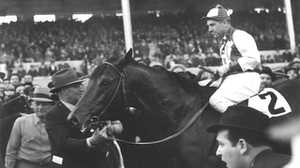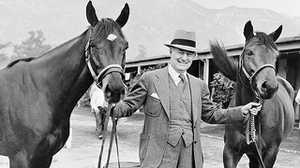Racing in the Depression

By the time the Great Depression descended on the nation like a bitter cold front, horse racing in the United States was already in a deep freeze. It had gone cold during the first decade of the twentieth century, after a series of race-fixing scandals triggered a wave of legislation making betting illegal. The sport crumbled. At the turn of the century there had been 300 racetracks nationwide; by 1908, only 25 remained. The American bans proved a boon to the Mexican horse racing business, and Tijuana became a betting mecca.
Racing Renaissance
In the 1930s impoverished state governments, in search of ways to increase revenues, returned to the potential honey pot of horse racing. In exchange for legalizing betting on the sport, one state after another exacted steep taxes on racing revenues. The deal was mutually beneficial to private investors and government tax collectors, and led to a 70 percent increase in the number of tracks across the country. At the racetrack, crowds turned up as large as any that had ever assembled to watch horse racing.
Big Money
In 1933, California legalized betting on horses and the sport found a home north of the Mexican border again. Near Los Angeles, investors spent about $3 million on the state-of-the-art Santa Anita Park, which thrilled horse owners and racing fans everywhere by offering a $100,000 winner-take-all prize in its signature annual event, the Santa Anita Handicap. Today, the prize would translate to over $7 million. Such extravagant prizes in economically sour times drew the horses, and the horses drew the fans.
Depression-Era Diversions
People visited the track by the thousands every day, eager for the drama of a horse race. Horse racing, along with baseball, dominated the sports world. Sports were not the only diversions available to Americans struggling to grind out a living. Movie theaters transported viewers to places as appealing as Oz, attracting 85 million people a week. Others preferred to take their escape around the living room radio, listening to the heroic exploits of The Lone Ranger or Little Orphan Annie.
Dreaming of a Pay Day
The horses’ power and beauty and the excitement of racing undoubtedly attracted many to the grandstands. Another draw, though, was the possibility of pay day that promised relief from the tight clamp of poverty for a week, a month, or, if a long shot finished first in the big one, even a lifetime.
The Only Place to Bet
“The opportunities for gambling in the 1930s were very limited,” says Gene Smith, the author of many books on racing. “There were no state lotteries. Football was a very minor sport. Professional basketball was a very minor sport. You wanted to bet on a prize fight, you had to go find a bookie or something. There were casinos in Nevada, but how many people go to Nevada? Hence the only place you could really bet was at a racetrack.”
Come On, Seabiscuit!
Seabiscuit was a true crowd-pleaser. Bettors, whether they were the hardcore daily ones or casual visitors, usually cheered a horse by its number: “Come on — Number Three!” A large percentage of horse fans seemed to connect with Seabiscuit, and he was one of the few horses they rooted for by name.
An Underdog Who Triumphed
Fans, struggling to survive in their day-to-day lives, might have identified with the horse because of his underdog status. His stance was not regal; his body was rather low-slung. He had an awkward-looking gait. He had been mistreated as a young horse, raced and whipped too often, treatment which had turned him into an under-achiever and a steady loser. He had his greatest success at a relatively old age, another reason for fans to embrace him. He also had what many thought would be a career-ending accident. Still, Seabiscuit came back to win the Santa Anita Handicap with his jockey Red Pollard, who had a matching hard-luck story. That race, and a glorious win, was his last, and it came in 1940, just as a trying decade was finally coming to a close. Says Gene Smith: “This is the story of every happy-ending fairytale that Mother read to us when we were in the nursery. And to a depression-ridden, anxious, frightened nation, it must have come like a great sunrise.”







